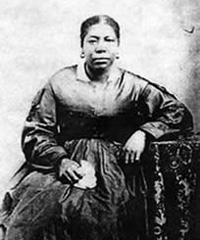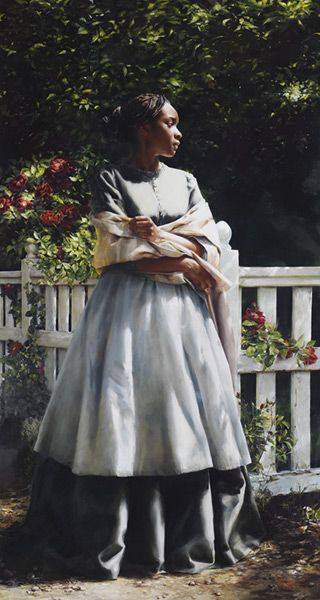Jane Manning James
Jane Elizabeth Manning James was an American pioneer and early member of The Church of Jesus Christ of Latter-day Saints. She was born on 22 September 1822 in Wilton Connecticut, one of five children of Isaac and Phyllis Manning, a free black family.
Contents
A Hunger and Thirst for Spiritual Knowledge
Although Jane was a member of the local Presbyterian congregation, she still had a hunger and thirst for more spiritual knowledge. In 1842, soon after hearing a missionary from The Church of Jesus Christ of Latter-day Saints preach, she embraced the restored gospel of Jesus Christ and spared no time in sharing the Good News with her family. She became a member of the Church not long after.
Journey to Nauvoo to Join the Saints
In 1843, Jane and eight members of her family began the arduous journey from Connecticut to Nauvoo, Illinois where they would join with other Latter-day Saints. Upon arriving in Buffalo, New York, they purchased tickets for passage on the steamboat, but after their luggage had been placed on board, they were denied boarding because they were Black. Neither their luggage or their money was returned to them. Being determined to continue to Nauvoo, Jane mustered her family and they traveled the 800 long miles to Nauvoo by foot. She recounted the incident:
- We walked until our shoes were worn out, and our feet became sore and cracked open and bled until you could see the whole print of our feet with blood on the ground. We stopped and united in prayer to the Lord, we asked God the Eternal Father to heal our feet and our prayers were answered and our feet were healed forthwith.
Arriving in Nauvoo, Illinois – The Favor of the Lord
When they reached Peoria, Illinois, they were met with another challenge. Law enforcement officials threatened to arrest them if they did not produce their freedom papers. Because Jane and her family were not slaves who had been granted their freedom, but rather were born free, they could not present the requested documents. The Lord was truly watching over them, and by His grace, they could convince the authorities that they were telling the truth. They could continue their journey and finally reached Nauvoo, but not before having to cross a stream of ice-cold water up to their necks.
Once in Nauvoo, Jane and her family were invited into the home of the Prophet, Joseph Smith, and his wife Emma. After hearing of their perilous journey, Joseph said, “God bless you. You are among friends; now you will be protected.”
Her family found housing in the new town and it was decided that Jane would live with the Smiths. In time, because of the friendship bond that had formed between Jane and the Smiths, Joseph and Emma asked her if she would like to be sealed to them as a member of their family.
The Trek to Zion
In 1841, Jane met and married another free Black and member of the Church, Isaac James.
After Joseph’s death in 1844, Jane lived with Brigham Young’s family until the trek west.
Following the martyrdom of Joseph Smith and his brother Hyrum in the Carthage jail in Carthage, Illinois, the persecution of the Saints continued to rise. In the fall of 1847, Jane, her husband, and their two sons made the decision to travel West with some of the other Saints. Not wanting to make another long journey, and unsure of what lay ahead, Jane’s family opted to not make the trek West to Utah.
While on the trek, Jane gave birth. In September 1847, she arrived in the Salt Lake Valley. She and her family would become the first free black pioneers in the Mormon settlement and Jane would spend the remaining fifty-one years of her life in Utah.
As the Saints settled into their new surroundings, many soon forgot about the brotherly love that they shared while in Nauvoo and started to create division among Saints of different skin colors. Instead of being referred to as Sister Jane, some began referring to her as Black Jane.
Stalwart in Faith and Testimony
Despite the change in the attitude of some of the Saints, Jane remained true to who she was as a woman of stalwart faith. Throughout her life, and in the face of many adversities, her testimony of the restored gospel of Jesus Christ was unwavering. Before she passed away on 16 April 1908 in Salt Lake City, Utah, she dictated an autobiography. She also gave an interview in 1905 concerning her memories of Joseph Smith. President Joseph F. Smith spoke at her funeral.
The Deseret News wrote the following about Jane Manning James on 16 April 1908:
- Few persons were more noted for faith and faithfulness as was Jane Manning James, and so of the humble of the earth, she numbered friends and acquaintances by the hundreds. Many persons will regret to learn that the kind and generous soul has passed from the earth.
In June 1999, the Genesis Group dedicated a monument to her life near her grave in the Salt Lake City Cemetery. In 2005, a 20-minute documentary of her life "Jane Manning James: Your Sister in the Gospel" was shown at the This Is the Place Heritage Park, at the annual FAIR conference, and on PBS.
Elspeth Young was commissioned to create a painting for the Payson Utah Temple. Her resulting portrait of Jane hangs in the temple and is part of Al Young Studio’s Pioneers of the American West Fine Art Collection. Young chose to paint Jane at the time of Joseph Smith’s martyrdom. Jane considered the Prophet to be “the finest man I ever saw on earth. . . . When he was killed, I liked to a died myself.”
References

